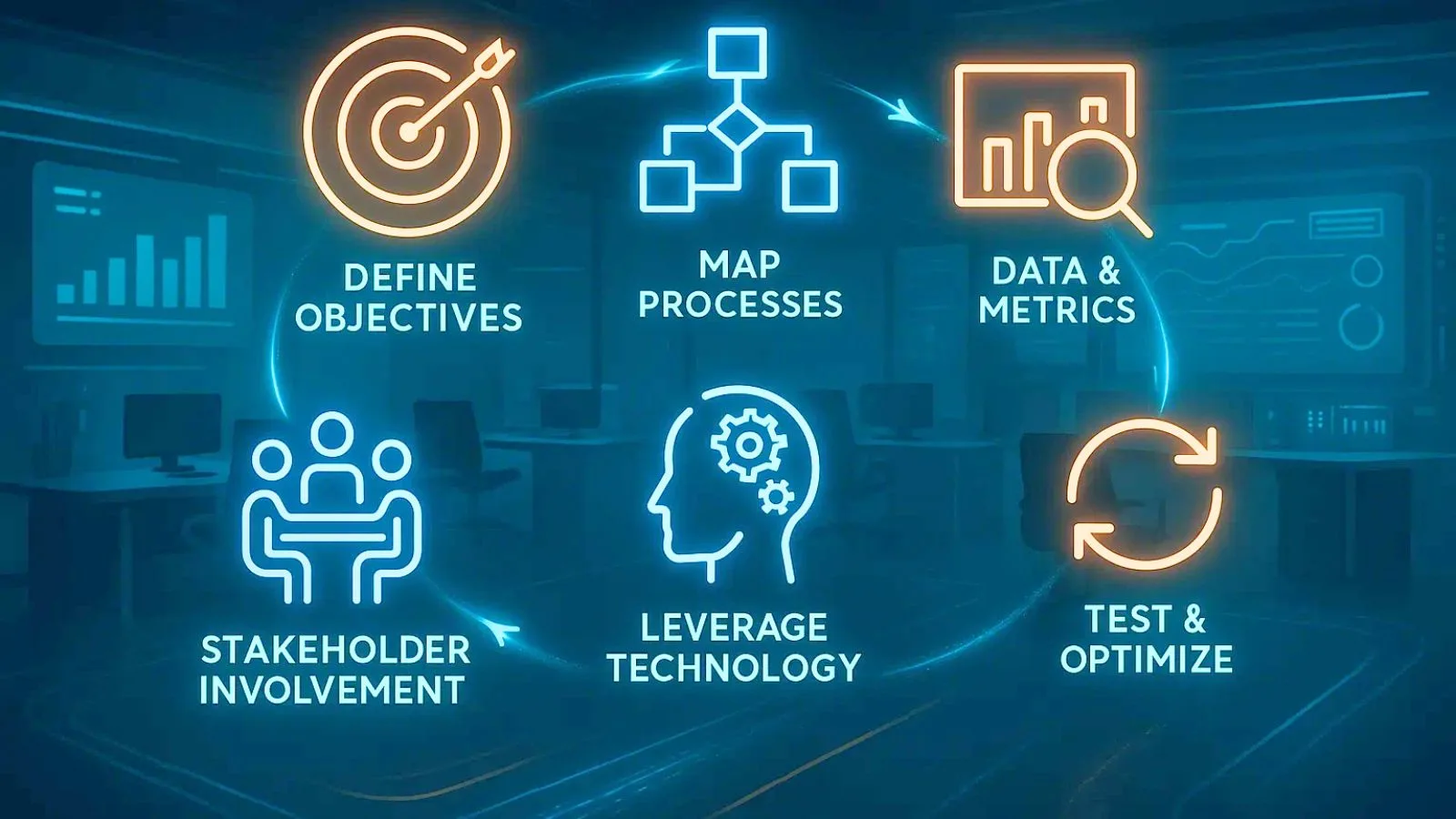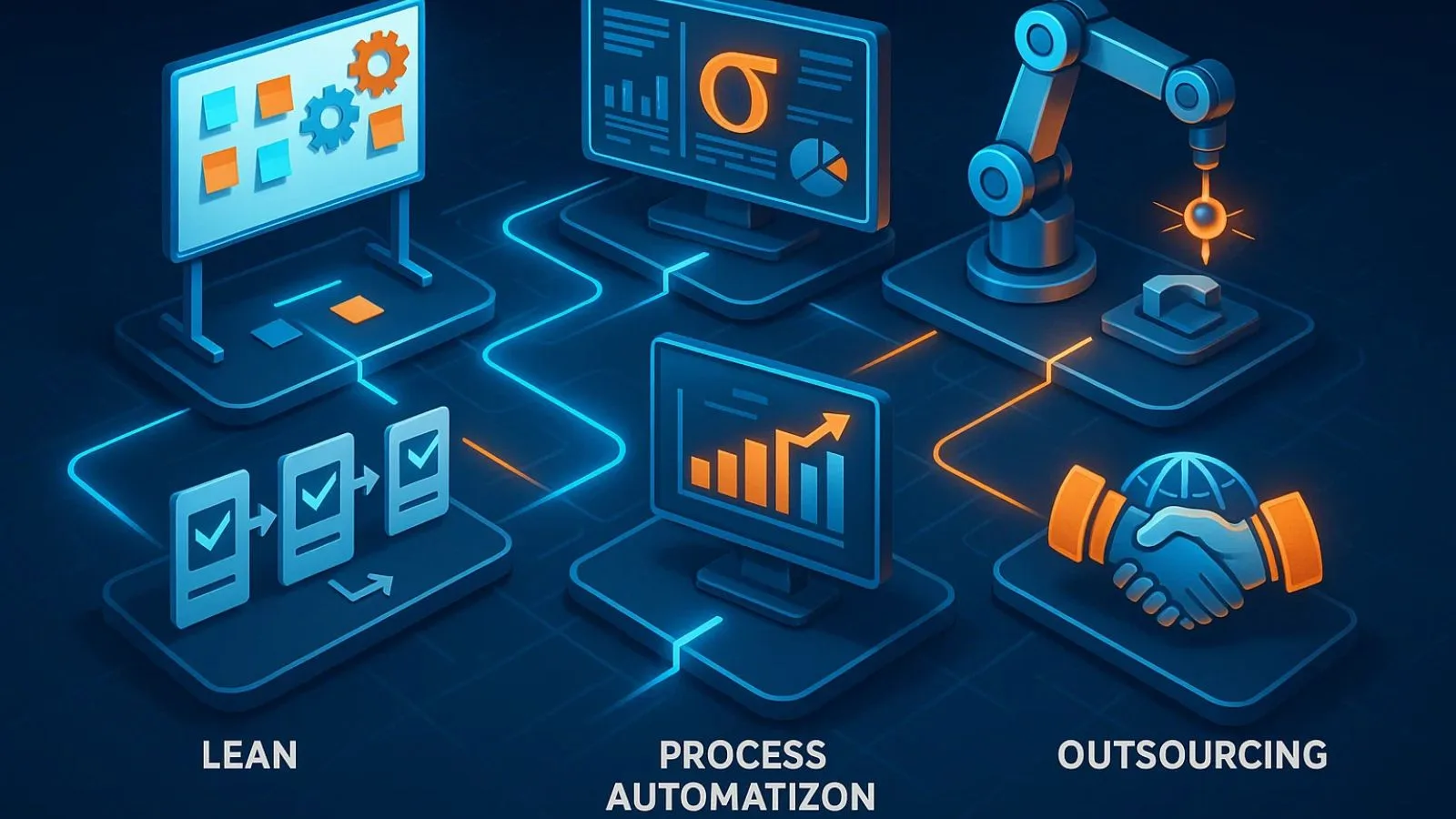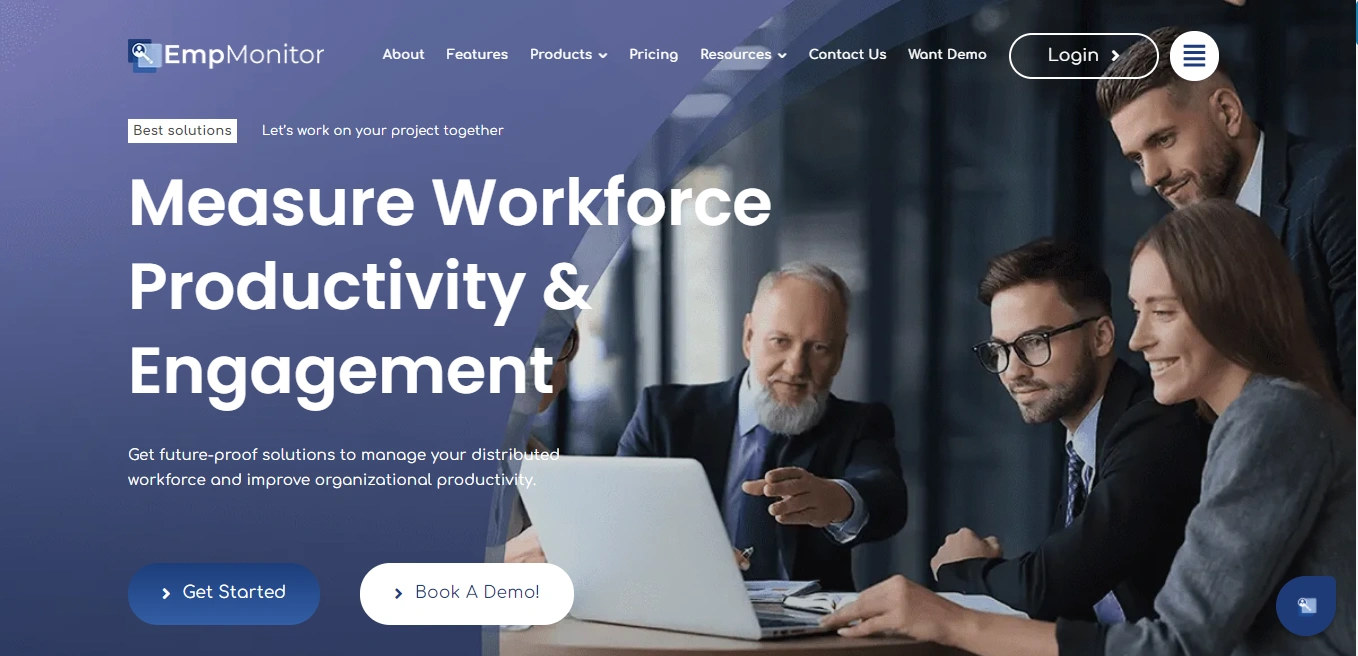Every business runs on process steps that help teams deliver products, serve customers, manage employees, and keep everything on track. But as businesses scale or face new challenges, those same processes can slow things down. Delays pile up. Costs increase. Teams get frustrated.
That’s where business process optimization steps in.
Put simply, business process optimization means identifying inefficiencies, fixing what’s broken, and streamlining how work gets done. It’s not about starting from scratch but improving what already exists, cutting out the clutter, and fine-tuning the workflow.
From small tweaks to complete overhauls, optimizing processes helps businesses move faster, serve customers better, and stay competitive in a fast-changing world. And in today’s digital age, where data and automation are everywhere, even small improvements can make a big impact.
In this blog, we’ll break down what business process optimization means, why it matters, and how you can start improving your workflows step by step.
What Is Business Process Optimization?
Business optimization is the practice of analysing and improving existing business processes to make them more efficient, streamlined, and effective. It focuses on removing unnecessary steps, reducing delays, cutting down costs, and improving quality or customer experience without changing the core goal of the process itself.
If you’re wondering what is business process optimization, think of it like fine-tuning an engine. You’re not replacing the car; you’re making sure every part runs at its best so the entire system performs better.
Some common goals of business process optimization include:
- Reducing redundant or manual tasks
- Minimizing errors and bottlenecks
- Speeding up task completion
- Improving employee and customer satisfaction
Businesses that adopt a smart business process optimization strategy often see measurable results in performance, agility, and profitability.
Modern optimization also embraces technologies such as automation, artificial intelligence, and analytics to make processes smarter and more data-driven. Tools like employee management software or workforce management software play a critical role in helping companies visualize their workflows, monitor performance, and implement changes faster.
Why Business Process Optimization Matters?
In today’s competitive market, efficiency isn’t just a buzzword; it’s a survival skill. Business process optimization helps companies cut waste, boost productivity, and respond faster to change. Without it, even the most innovative businesses can become tangled in outdated systems and inefficiencies.
Imagine running a business where every step takes longer than it should, employees are confused about priorities, and customer complaints keep piling up. That’s what happens when processes aren’t optimized.
Here’s why optimizing processes is non-negotiable:
- Improved Efficiency: Streamlined processes mean less time spent on unnecessary tasks and more time focused on what matters.
- Cost Savings: Reducing delays, errors, and redundancies can save significant amounts over time.
- Enhanced Customer Experience: Faster, smoother internal operations lead to quicker and better service delivery.
- Greater Agility: In a world that changes fast, optimized processes let you pivot or scale quickly.
- Employee Satisfaction: A well-organized workflow reduces stress, improves clarity, and helps people perform their roles with confidence.
As businesses scale, processes often become more complex. That’s why having a smart business process optimization strategy in place is key. Leveraging workforce Planning software or employee management software gives decision-makers real-time insights to identify bottlenecks and act on them proactively.
Simply put, business optimization helps organizations get more done, using fewer resources and with better results.
Key Elements of a Strong Business Optimization Strategy
Crafting a winning business process optimization strategy doesn’t have to be complicated. It just needs to be thoughtful, data-driven, and adaptable. Here are the core elements that make a strategy effective and sustainable:
1. Define Clear Objectives
Before anything else, clarify what you want to achieve. Are you looking to reduce turnaround time? Improve customer satisfaction? Lower operational costs? Knowing your goals keeps your optimization efforts focused and measurable.
2. Map Existing Processes
You can’t improve what you don’t fully understand. Begin by breaking down your existing workflows into clear, step-by-step processes. This gives you visibility into how work gets done, not just how you think it gets done.
Use visual aids like flowcharts or diagrams to spot delays, repeated steps, or areas where results aren’t consistent.
3. Gather Data and Metrics
Optimization thrives on data. Collect metrics like:
- Process completion times
- Error rates
- Customer feedback
- Employee input
This data provides a baseline and shows you where the inefficiencies live. It also helps you track improvement over time.
4. Involve Key Stakeholders
Employees on the ground often know where things break down. Get their input early. They can offer practical solutions, highlight pain points, and help make the changes stick.
Collaboration also boosts morale and encourages adoption of new workflows.
5. Leverage Technology
The right tech can simplify, automate, and track processes in real-time. This is where AI business optimization solutions shine. Tools like workforce management software and employee management software can identify inefficiencies, assign tasks automatically, and generate performance insights with minimal human input.
This lets teams stay focused on high-impact work while software handles the repetitive stuff.
6. Test, Optimize, Repeat
Business optimization isn’t a one-time event. It’s an ongoing cycle. Once you’ve made improvements, test the results and adjust as needed. Use the feedback loop to fine-tune performance, even after you hit your initial goals.
Having a clear, actionable business process Management strategy ensures that your improvements aren’t just temporary fixes but long-term upgrades that stick.
Proven Techniques For Business Optimization
Once you’ve got your strategy in place, the next step is applying the right techniques. These practical methods can dramatically improve how your processes function, making your entire operation smoother, faster, and more cost-effective.
- Lean Methodology
Lean focuses on eliminating anything that doesn’t add value—waste, delays, redundant steps. The idea is to streamline processes so you can deliver more value with fewer resources.
Some common Lean tools include:
Value Stream Mapping: Visualizing every step of the process to spot inefficiencies
5S System: A workplace organization method (Sort, Set in order, Shine, Standardize, Sustain)
Kaizen: Continuous, incremental improvement driven by employees
- Six Sigma in Business Optimization
Six Sigma helps improve quality by reducing mistakes and getting processes as close to perfect as possible.
It uses a data-driven approach, relying heavily on metrics and structured improvement techniques like DMAIC (Define, Measure, Analyze, Improve, Control).
If you’re trying to improve process consistency, reduce defects, or meet compliance requirements, Six Sigma is a powerful technique.
- Process Automation
Manual tasks tend to be slower and more prone to mistakes.
With automation, tasks like data entry, notifications, approvals, and reporting can be handled by software, leaving your team free to focus on higher-level work.
This is where AI business process optimization solutions come into play. AI can intelligently route tasks, identify bottlenecks, and even predict future process failures before they happen.
- Workflow Standardization
When every team member follows their way of doing things, chaos follows. Standardizing workflows helps ensure consistency, quality, and predictability. It also makes it easier to onboard new employees and maintain compliance.
- Performance Monitoring
You can’t optimize what you don’t track. Use employee management software or workforce management software to monitor productivity, task timelines, and performance KPIs. These tools help you detect when processes slow down or stray from expected outcomes, so you can step in early.
- Outsourcing and Delegation
Sometimes the best optimization is letting someone else do the work. Outsourcing non-core functions (like payroll or IT support) frees your team to focus on what they do best. For global companies, this might include region-specific services such as IT Support in China, which helps international teams operate smoothly without communication or compliance challenges.
Delegation within your team can also speed things up, provided tasks go to the right people with the right skills.
By combining these techniques, you can build a system that’s not just optimized for today but flexible enough to evolve with your business tomorrow.
How EmpMonitor Supports Business Process Optimization?
When it comes to putting your business optimization strategy into action, having the right tools can make a big difference. That’s where EmpMonitor steps in, offering features specifically designed to streamline workflows, improve productivity, and help you gain better control over your operations.
1. Real-Time Employee Monitoring
EmpMonitor allows you to track employee activities in real time. You can see:
- Which tasks are employees working on
- How much time is spent on productive vs. non-productive activities
- Application and website usage
This kind of transparency gives you the insights needed to spot inefficiencies and make data-backed decisions.
2. Automatic Time Tracking and Attendance
Manual attendance logs aren’t just old-fashioned; they also make it easy for mistakes to happen. EmpMonitor automates this process. It records when employees log in, log out, take breaks, or remain idle. You can use this data to analyze work patterns and identify areas for improvement.
It’s like having a focus time clock built into your workflow engine so your team stays aligned without the micromanagement.
3. Workflow and Productivity Reports
With EmpMonitor, you don’t need to dig through spreadsheets. It generates detailed reports on individual and team performance daily, weekly, or monthly.
You can quickly identify:
- Which departments or individuals are underperforming
- Which tasks take longer than expected
- Where are you losing time across your process
It acts as a live feedback loop to fuel your business optimization strategy.
4. Data-Driven Decision Making
EmpMonitor transforms raw data into actionable insights. If you’re working on a Six Sigma in business process optimization project, this kind of granular visibility supports your measurement and analysis stages.
Want to reduce waste or track how changes impact performance? EmpMonitor lets you easily view and compare past and present data side by side.
5. Secure and Scalable
Business growth brings more processes and often, more complexity. EmpMonitor’s cloud-based system scales with your business. It offers multi-location tracking, secure data storage, and role-based access, making it a practical tool for startups and enterprises alike.
In short, EmpMonitor is more than just an employee management software. It’s a complete solution for modern teams looking to simplify operations, improve visibility, and enhance performance through business optimization.
Common Challenges in Business Process Optimization (And How to Overcome Them)
Even though the benefits of business process optimization are massive, many teams still run into roadblocks when trying to put it into practice. Here are some of the most common challenges and practical ways to tackle them.
- Resistance to Change
People tend to stick with what they know, even if it’s not the most efficient way to do things.
When you introduce process changes, some team members may resist because they’re afraid of learning new tools or losing control.
How to overcome it:
Involve your team in the process from the beginning. Communicate clearly about the “why” behind each change. Make use of simple tools and offer training. Highlight how these changes will make their jobs easier, not harder.
- Lack of Data Visibility
Trying to improve a process without accurate data is like navigating in the dark. You might rely on assumptions rather than facts, which leads to poor decisions.
How to overcome it:
Use tools like EmpMonitor or other employee management software that provide real-time data and reporting. With better visibility into performance and time usage, you can make smarter decisions and back them up with real metrics.
- Outdated Technology or Tools
If your systems are slow, disconnected, or can’t handle automation, your optimization efforts will stall. Legacy tools often create bottlenecks that hurt efficiency and frustrate your team.
How to overcome it:
Invest in modern tools that support AI business optimization solutions. These platforms integrate easily with existing workflows and give you more flexibility and speed.
- Undefined Objectives
If your team doesn’t know what success looks like, it’s impossible to measure it. Vague or shifting goals can stall your progress and lead to confusion.
How to overcome it:
Set clear, measurable goals for every phase of your business optimization. Are you aiming to reduce time spent on a task by 20%? Do you want to cut costs by 15%? The more specific, the better.
- Scaling Issues
A process that suits a team of 10 may not be effective for a team of 100. As your business scales, your workflows need to grow with it.
If they don’t, they become roadblocks instead of support systems.
Conclusion: Make Optimization a Habit, Not a Project
Business process optimization isn’t just a one-time fix; it’s a long-term mindset. It’s about regularly stepping back to ask: Is there a better, faster, or smarter way to do this? Whether you’re streamlining team communication, reducing repetitive manual work, or improving turnaround time, every small improvement adds up to big results.
With the right strategy, clear goals, and the willingness to adapt, you can reduce costs, boost productivity, and empower your team to work more efficiently. Using modern tools, like EmpMonitor, helps automate tracking, identify bottlenecks, and ensure that your team is aligned with your business goals. For businesses looking for expert guidance, Business Process Optimization Consulting can provide tailored strategies and hands-on support to accelerate results.”
Remember: The best businesses don’t just run, they evolve. And optimizing your processes is the smartest way to stay agile, competitive, and future-ready.
FAQs
Q1. What is business process optimization in simple terms?
A: Business optimization means improving how tasks are done within a company to make them faster, more efficient, and less costly. It focuses on eliminating waste, reducing delays, and using resources more wisely.
Q2. How is Six Sigma used in business process optimization?
A: Six Sigma in business optimization provides a structured, data-driven approach to eliminate errors and inconsistencies. It uses proven methodologies like DMAIC (Define, Measure, Analyze, Improve, Control) to boost efficiency and ensure high-quality results.
Q3. What tools can help optimize business processes?
Tools like EmpMonitor are key to making process improvements more efficient. It helps track employee productivity, monitor workflows, analyze task performance, and spot inefficiencies in real time, making your operations more transparent and streamlined.















